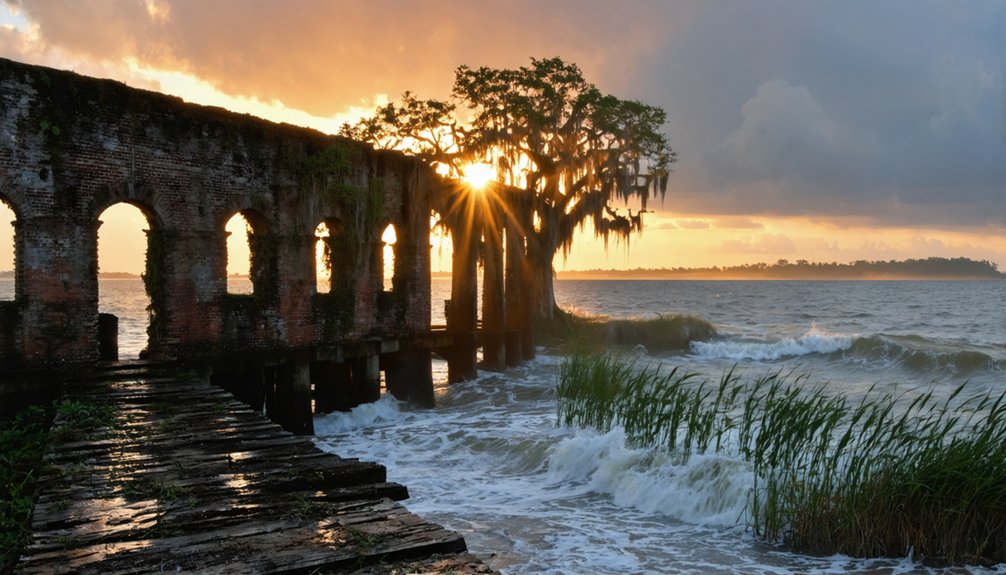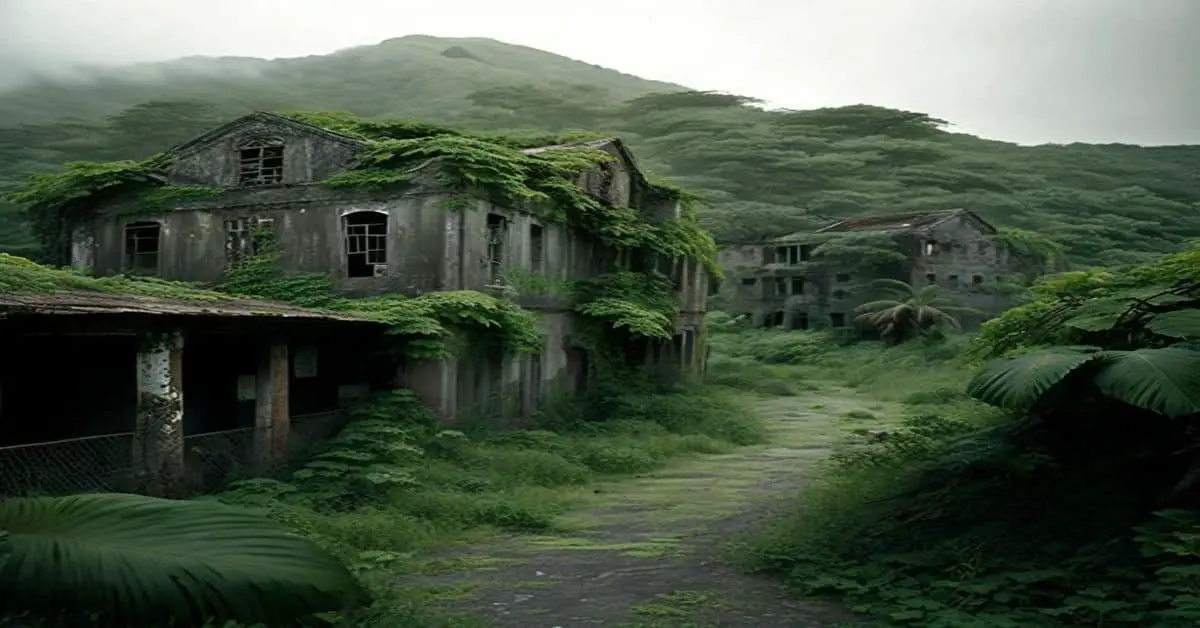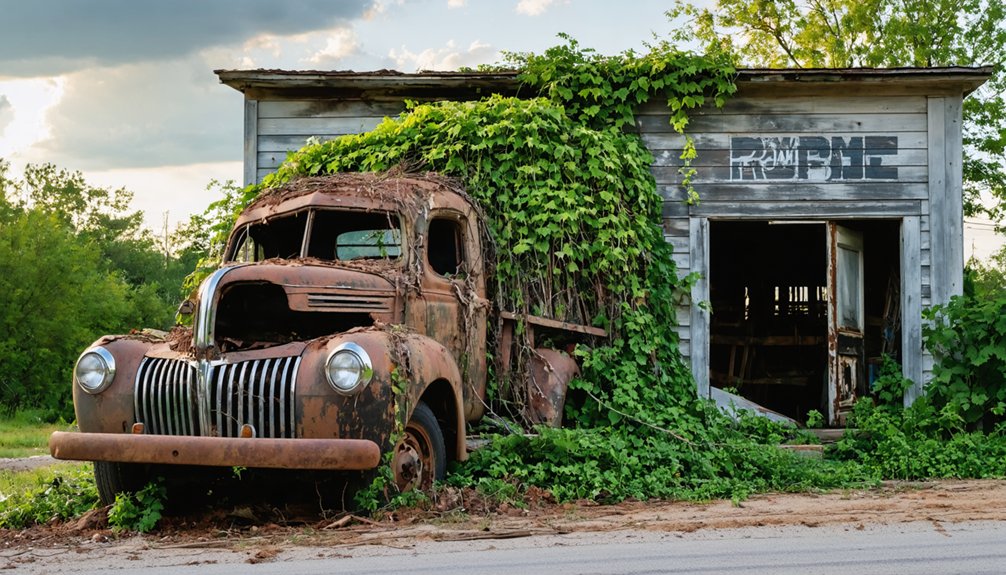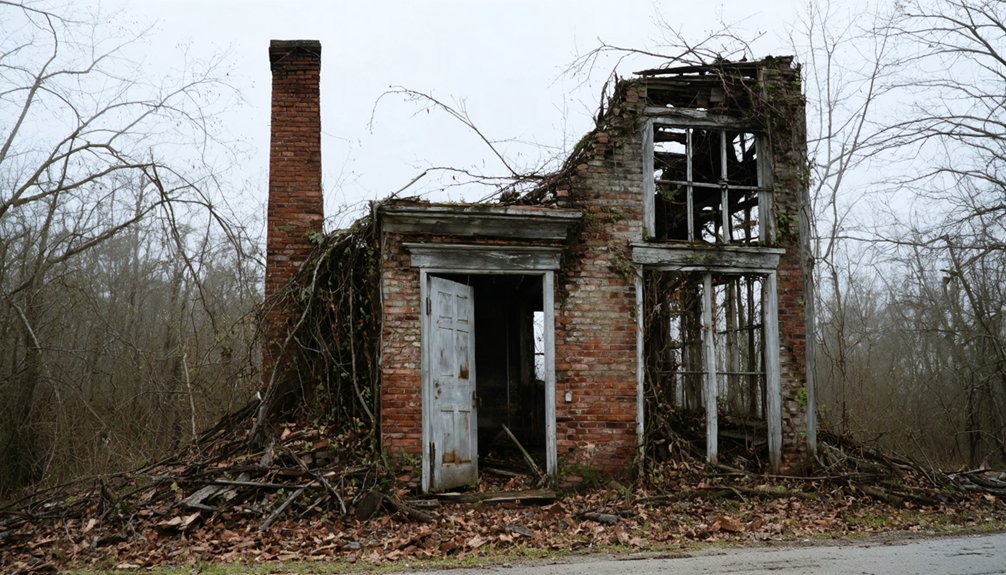You won’t find a traditional ghost town at Fort Morgan, but you’ll discover something more intriguing: a haunted 19th-century fortress guarding Mobile Bay’s entrance. Built between 1819-1834, this star-shaped citadel witnessed intense Civil War battles, including Admiral Farragut’s famous siege in 1864. Today, the fort’s massive brick walls and hidden corridors hold tales of spectral soldiers, mysterious footsteps, and unexplained phenomena that continue to intrigue visitors and investigators alike.
Key Takeaways
- Fort Morgan is not a traditional ghost town but a historic military fort with reported paranormal activity and abandoned structures.
- The fort was declared obsolete in 1923 and subsequently abandoned by the military, though later preserved as a historic site.
- Mysterious footsteps, unexplained cries, and ghostly encounters have been reported around the fort’s central barracks and citadel area.
- The site features remnants of Civil War-era structures, including hidden corridors and abandoned military buildings that visitors can explore.
- EMF detectors and infrared cameras have documented unexplained phenomena, attributed to lingering spirits of Civil War soldiers.
The Strategic Gateway to Mobile Bay
Fort Morgan’s position at Mobile Point established it as one of the most strategically important fortifications along the Gulf Coast, standing guard over the main shipping channel into Mobile Bay.
As part of America’s Third System of coastal fortifications, you’ll find this star-shaped fortress was expertly designed to control maritime traffic and defend against both naval and land-based threats.
Built over 15 years and completed in 1834, the fort’s military strategy centered on its ability to direct devastating artillery fire at any vessel attempting to enter the bay. Construction relied heavily on slave-made bricks transported by ships to the building site.
Working in concert with Fort Gaines and Fort Powell, it created an imposing defensive network that protected not only Mobile’s essential ports but also secured interior Alabama from potential invasions through this significant waterway. The fort was a prime target during the Civil War and surrendered to Union forces following the Battle of Mobile Bay in 1864.
From Fort Bowyer to Fort Morgan
You’ll find the earliest American defenses of Mobile Bay in Fort Bowyer, hastily constructed in 1813 using earth and logs to guard against British naval threats.
Originally armed with fourteen cannon, the fort proved its military value despite its simple construction. The fort’s strategic importance became clear when it repelled a British attack in September 1814, though it later fell to overwhelming British forces in February 1815 during the war’s final land battle. Major Lawrence led his troops with distinction during the first battle.
After the War of 1812, the U.S. government replaced Fort Bowyer with the more formidable Fort Morgan, built between 1819 and 1834 to establish permanent control over this vital gateway to Mobile Bay.
Early Defense History
The strategic importance of Mobile Point became evident in the early 1700s, leading to centuries of military fortification at the entrance to Mobile Bay.
You’ll find the site’s military significance was first demonstrated by Fort Bowyer, a wooden structure built in 1813 that successfully repelled two British attacks in 1814-1815.
After the War of 1812, the U.S. government recognized the need for stronger coastal fortifications and included Mobile Point in its “Third System” of masonry forts.
Construction of Fort Morgan began in the 1820s to replace Fort Bowyer, featuring a star-shaped design that maximized artillery coverage of the bay’s shipping channel.
The fort’s initial garrison under Capt. F. S. Belton maintained thirty-five guns, though by 1841 it was reduced to a caretaker force.
The construction faced early setbacks when yellow fever epidemics claimed the life of the initial contractor Benjamin Hopkins in 1819.
By 1868, the fort was nearly deserted as the 15th U.S. Infantry departed, leaving the structure in need of modernization.
British Attack Repelled
During the pivotal autumn of 1814, British forces launched an ambitious assault on Fort Bowyer, where Major William Lawrence and his American garrison stood ready to defend Mobile Bay’s strategic entrance.
The British tactics involved a coordinated attack using four warships, Royal Marines, and Creek Indian allies.
You’ll find that American resilience prevailed decisively – the defenders sank HMS Hermes, damaged another vessel, and repelled the invasion while suffering minimal casualties.
The humiliating British defeat, with 33 killed and 40 wounded compared to America’s 4 killed and 5 wounded, forced the enemy to abandon their plans of capturing Mobile and advancing toward New Orleans via Mississippi trade routes.
This victory boosted U.S. morale and triggered celebrations across the young nation.
Following this battle and the signing of the Treaty of Ghent, the U.S. Army recognized the need for stronger coastal defenses and began construction of Fort Morgan to replace Fort Bowyer. The new fortress was constructed using granite from New York, a much more durable material than the original fort’s logs and sand.
Strategic Location Dominates
Following the British defeat at Fort Bowyer, military strategists recognized that a more formidable fortification would be needed to protect Mobile Bay’s vital entrance.
You’ll find that Fort Morgan’s construction, beginning in 1819, wasn’t just a simple upgrade – it represented a complete transformation of Mobile Point’s maritime security capabilities.
The geopolitical implications were clear: whoever controlled this strategic chokepoint could dominate regional commerce and military movements.
That’s why engineers designed the new pentagonal bastion fort using over 46 million cubic yards of brick, creating thick protective walls that could withstand naval bombardment.
Working alongside skilled masons, enslaved African Americans helped construct this massive fortress that would command both landward and seaward approaches, effectively replacing Fort Bowyer’s limited earthen and wooden defenses.
The initial project faced early setbacks when Benjamin Hopkins died during the devastating yellow fever epidemic of 1819.
Civil War Battles and Military Legacy
You’ll find Fort Morgan’s most dramatic moment occurred in August 1864, when Admiral Farragut’s Union fleet boldly forced its way past the fort’s heavy guns into Mobile Bay.
During the subsequent land siege, Union forces pounded the fort with over 3,000 artillery rounds in just twelve hours, setting the citadel ablaze and forcing Confederate General Page to dump 60,000 pounds of gunpowder into cisterns.
The fort’s strategic location at Mobile Point had made it the key defender of the bay’s only deep-water channel, which Confederate blockade runners had used successfully until the fort’s surrender on August 23, 1864. The fort was defended by a garrison of 600 men who fought against overwhelming Union forces of 5,500 troops.
Under Admiral Farragut’s command, a formidable Union fleet of 14 wooden vessels and four ironclads launched a decisive assault on Fort Morgan in Mobile Bay. His naval strategies proved revolutionary, as he ordered wooden ships to be lashed together in pairs for mutual protection while ironclads led the charge.
The bombardment’s historical significance became clear on August 22nd when Union forces released a devastating 24-hour assault, firing over 6,000 rounds at the fort.
You can imagine the intensity as shells rained down, destroying essential supplies and making it impossible for Confederate defenders to maintain their positions. With food and water depleted and their defenses crumbling, Fort Morgan’s garrison had no choice but to surrender the following morning, marking a significant victory in the Union’s campaign to strangle Confederate supply lines.
Strategic Bay Defense Position
Built in 1817 as part of America’s Third System of coastal defenses, Fort Morgan occupied a commanding position at Mobile Point, where it controlled access to one of the Confederacy’s most significant harbors.
The fort’s defensive architecture showcased state-of-the-art military strategy, featuring a pentagonal bastion design that could withstand attacks from both land and sea.
Working in tandem with Fort Gaines on Dauphin Island, Fort Morgan created an imposing crossfire system that protected essential Confederate supply lines through Mobile Bay.
You’ll find the fort’s strategic importance evident in its heavy artillery placement, which covered the narrow ship channel leading into the bay.
This positioning proved critical during the Civil War, as it forced Union Admiral Farragut’s fleet to navigate a deadly gauntlet of guns and underwater mines in 1864.
Haunting Tales From the Barracks
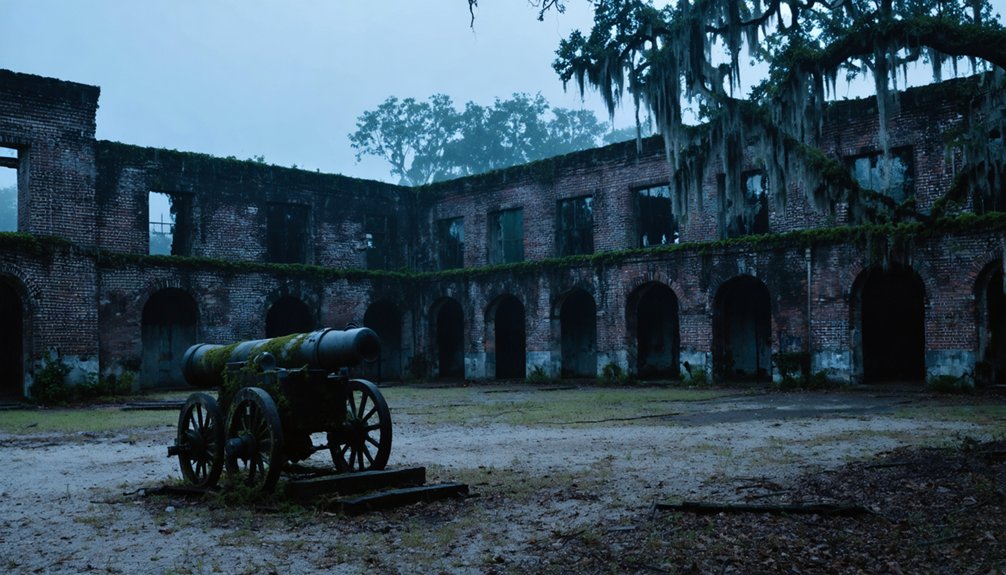
Deep within Fort Morgan‘s battle-scarred walls, the central barracks known as the citadel harbors some of the most compelling ghost stories from this historic military post.
The ten-sided brick structure, completed in 1825, witnessed intense fighting during the Civil War siege of 1864, when Union bombardment set its wooden roof ablaze.
Built in 1825, this decagonal fortress endured fierce Civil War combat, its wooden crown consumed by Union artillery fire.
You’ll find tales of spectral soldiers lingering around the dismantled citadel’s footprint, where Confederate and Union troops once lived and died.
The barracks hauntings intensified after World War I, when up to 2,000 troops trained here.
Local legend suggests that the violent destruction of these living quarters, combined with the suffering of countless soldiers through multiple wars, has left an otherworldly imprint on this strategic fortification’s grounds.
Unexplained Phenomena and Spectral Sightings
What lurks in Fort Morgan’s dark corners after sunset?
You’ll discover a world of unexplained phenomena where ghostly encounters have become routine occurrences. Visitors regularly report seeing the spirit of a young woman who met a tragic end in the 19th century, while others encounter the restless soul of a prisoner who took his own life in 1917.
During paranormal investigations, you’ll detect mysterious footsteps echoing through empty corridors and hear unexplained cries carried on the night wind.
Using EMF detectors and infrared cameras, you can track spectral activity throughout the fort’s historic grounds. The Civil War battlefield’s energy remains particularly active, with soldiers’ spirits still seemingly patrolling the ramparts.
These phenomena have transformed Fort Morgan into one of Alabama’s most compelling paranormal destinations.
Architectural Features and Hidden Passages
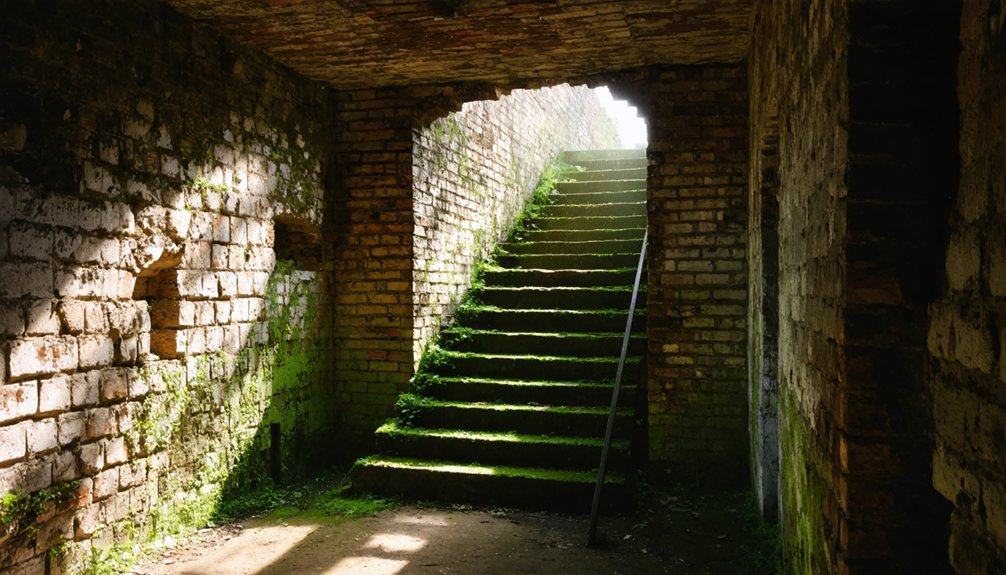
Standing as a tribute to 19th-century military engineering, Fort Morgan‘s massive star-shaped design incorporates over 40 million locally manufactured bricks.
You’ll discover architectural marvels throughout the structure, from its impressive arched entryways to its strategic defensive positions, all meticulously designed by the U.S. Army Corps of Engineers.
As you explore the fort’s hidden corridors, you’ll encounter steep staircases leading to various bastions and dark chambers that spark curiosity about untold secrets.
The extensive network of hallways, some completely unlit, creates an atmosphere of mystery enhanced by optical illusions.
While certain rooms remain chained off, you’re free to investigate most areas through self-guided tours.
The fort’s isolated location on Mobile Point adds to its mystique, making it a fascinating example of 19th-century military architecture.
Preservation Efforts Through the Ages
After serving as an essential coastal defense fortification for nearly a century, Fort Morgan faced a significant change in 1923 when military officials declared it obsolete.
A fortress that guarded Alabama’s coast for 100 years fell silent in 1923, deemed outdated by advancing military technology.
You’ll find that preservation efforts began when Alabama acquired the fort in 1927, marking a shift from military functionality to historical significance. While restoration challenges emerged during periods of neglect, the fort’s importance hasn’t diminished.
- The state’s Historical Commission maintains dedicated preservation programs
- Living history demonstrations bring the fort’s military past to life
- Federal and state grants fund critical structural stabilization
- Coastal erosion and weather exposure require constant vigilance
- Volunteer programs actively support ongoing preservation work
Despite being listed as one of America’s most endangered battle sites in 2007, Fort Morgan continues to stand as a symbol of Alabama’s commitment to preserving its military heritage.
Visiting the Historic Fortress Today
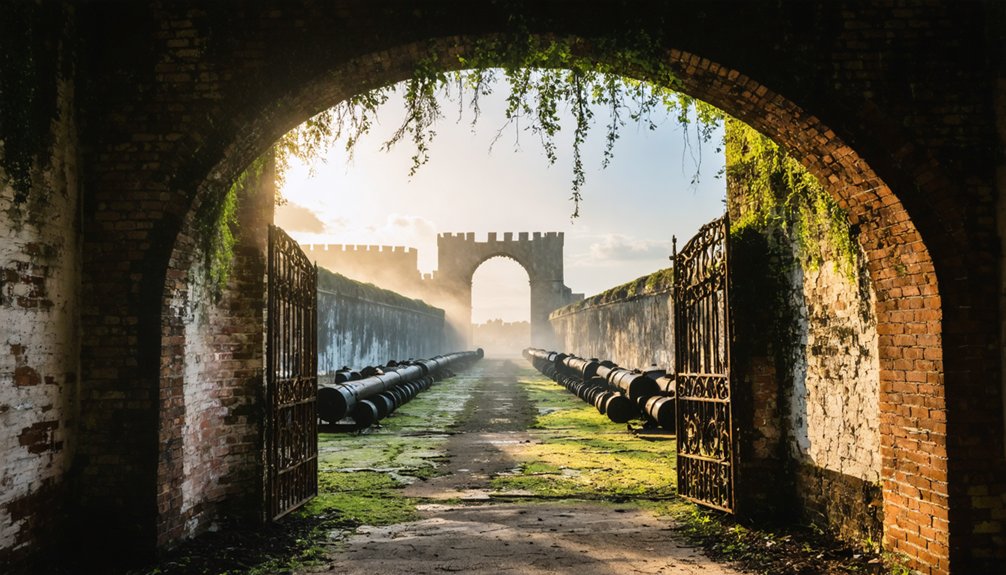
Located at the strategic entrance to Mobile Bay, Fort Morgan welcomes visitors today as one of Alabama’s premier historic attractions.
You’ll find guided tours available daily during peak season, while self-guided options let you explore year-round at your own pace. The on-site museum exhibits showcase Civil War artifacts, artillery, and maps, with knowledgeable interpreters ready to share the fort’s rich military history.
As you venture through the star-shaped fortress, you can explore ruined rifle pits, underground tunnels, and massive brick ramparts offering stunning views of the Gulf.
The historic batteries and casemates remain accessible, though some areas have uneven surfaces. While there aren’t food concessions on-site, you’ll find picnic areas perfect for a break, plus a museum shop stocked with books and educational materials about the fort’s significance.
Frequently Asked Questions
What Wild Animals and Wildlife Can Visitors Encounter at Fort Morgan?
You’ll find wildlife encounters with alligators, sea turtles, dolphins, deer, and bobcats, while animal sightings of migratory birds, armadillos, coyotes, and marine life are common throughout the area.
Are There Any Underwater Artifacts or Shipwrecks Near Fort Morgan?
You’ll find several historic shipwrecks near Fort Morgan, including the Civil War-era USS Tecumseh and CSS Gaines. Underwater exploration and shipwreck archaeology reveal countless artifacts from blockade runners and colonial vessels.
How Many People Died Within Fort Morgan’s Walls Throughout History?
Through war and peace, victory and defeat, you’ll find historical deaths at this fort numbered around 20-25 souls, including 8 Civil War casualties and 9 from the War of 1812’s battles.
What Native American Tribes Originally Inhabited the Fort Morgan Peninsula Area?
You’ll find that Creek Tribe members were among the later inhabitants, while evidence shows earlier Woodland peoples and Choctaw Culture groups originally lived along this coastal peninsula’s rich waters.
Does Fort Morgan Offer Overnight Camping or Accommodation Options for Visitors?
With 496 improved campsites at Gulf State Park nearby, you’ll find diverse camping facilities and lodging options, from RV parks with full hookups to beachfront accommodations along Mobile Bay’s shores.
References
- https://alabamaliving.coop/articles/ghosts-spirits-said-to-wander-the-grounds-at-fort-morgan/
- https://en.wikipedia.org/wiki/Fort_Morgan_(Alabama)
- https://alabamascoastalconnection.com/2021/10/12/ghost-stories-at-fort-morgan/
- https://www.liquidlifevacationrentals.com/blog/Legends-and-lore-of-the-alabama-gulf-coast
- https://www.youtube.com/watch?v=4Y2adHaH7c8
- https://midnightarchives.com/fort-morgan-ghost-stories/
- https://www.legendsofamerica.com/al-fortmorgan/
- https://encyclopediaofalabama.org/article/forts-morgan-and-gaines/
- https://ahc.alabama.gov/properties/ftmorgan/ftmorgan.aspx
- https://armyhistory.org/a-tale-of-two-forts/
